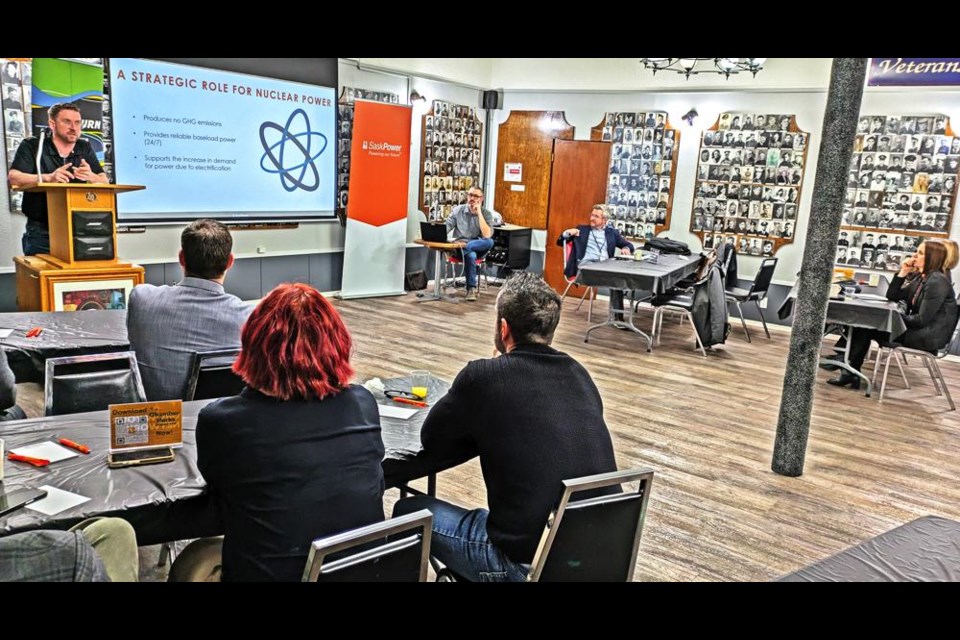WEYBURN - The planning work and the regulatory processes will take SaskPower years to complete before they decide in late 2029 if they will go ahead to build two small modular nuclear reactors in the Estevan area.
This was part of the message to members of the Weyburn Chamber of Commerce, as they hosted SaskPower for a lunch-and-learn session on Feb. 11 at the Weyburn Legion Hall.
To answer the question of “why nuclear, and why now?”, engineer Darcy Holderness explained the current and coming situation for SaskPower.
Between 30 and 40 per cent of power generation uses natural gas right now, hydro provides about 20 per cent, coal generation is about 22 per cent, and some power is produced by solar and wind, with SaskPower’s grid producing around 3,500 megawatts of power on any given day.
The timeline right now is staff are planning around two 300 megawatt-small modular nuclear plants, with sites narrowed down to two in the Estevan area. Sites had also been considered in the Elbow area, but those are now set aside.
The two sites right now are on Rafferty Dam, about nine km south of Macoun, and the other is on Boundary Dam south of Estevan. The final site or sites will be finalized by this summer, said Holderness.
SaskPower will then take until the end of 2029 to make their decision to actually go ahead to build, and if they do, there is another five-year period for construction, so a modular nuclear plant would not be producing power until about 2034 or 2035 at the earliest.
There are a lot of costs associated with these plants, such as safety requirements, the lengthy regulatory process needed, and a full decommissioning plan to be in place, with the money to cover it in the bank, plus plans for the safe operation and disposal of used nuclear waste.
Benefits of going with small modular nuclear plants include no greenhouse gas emissions whatsoever; it’s very cost effective; the 300 megawatt size is perfect for Saskatchewan’s power grid size; it’s very reliable, and uses assets available here, namely a constant supply of uranium, as Saskatchewan has one-third of the world’s supply.
Explaining what happens to spent nuclear fuel, Holderness said first the waste has to sit in a wet storage pool for seven or eight years, as the water fully shields the radiation as it begins to cool down. Then, while still in the water, the fuel is loaded into containers which are welded shut, and the goal is to have these shipped to a central underground storage area for spent nuclear waste.
This site is currently under construction and should be ready to take waste by the 2040s, from all nuclear facilities in Canada.
The specific plant being considered by SaskPower is a unit made by GE Hitachi, which uses a boiling water reactor, said Holderness. There are about 33 of these units in place around the world and in the U.S., and Saskatchewan is looking to scale these down to 300mW units for this province’s use.
The reactor unit would be placed about two-thirds underground adjacent to a thermal power plant, not unlike what is in place at Estevan currently where coal is used to generate the power.
For the two sites they’re looking at, the actual plant site will only use about 15 acres each, but the most important feature is the access to the water for use in the power generation process.
The cost estimate currently is around $5 billion, said Holderness, but right now SaskPower is in the conceptual cost phase. He also pointed out the first plant will cost much more than the second one will, with estimates the second plant may cost as much as 40 per cent less.
Once completed, he estimated it would have a workforce of about 120 to 140 personnel, compared to one of the Estevan plants which has around 100 personnel on site, not counting contractors brought in as needed.
Asked why not locate a Candu reactor on Lake Diefenbaker, with the ability to produce much more than the 300mW of power these small modular reactors would, Holderness said it is something that could be looked at.
The only way it would be economically feasible is if there were agreements in place with other jurisdictions to purchase power, or if a big data centre were to locate in the province which would require a large amount of power to run.



